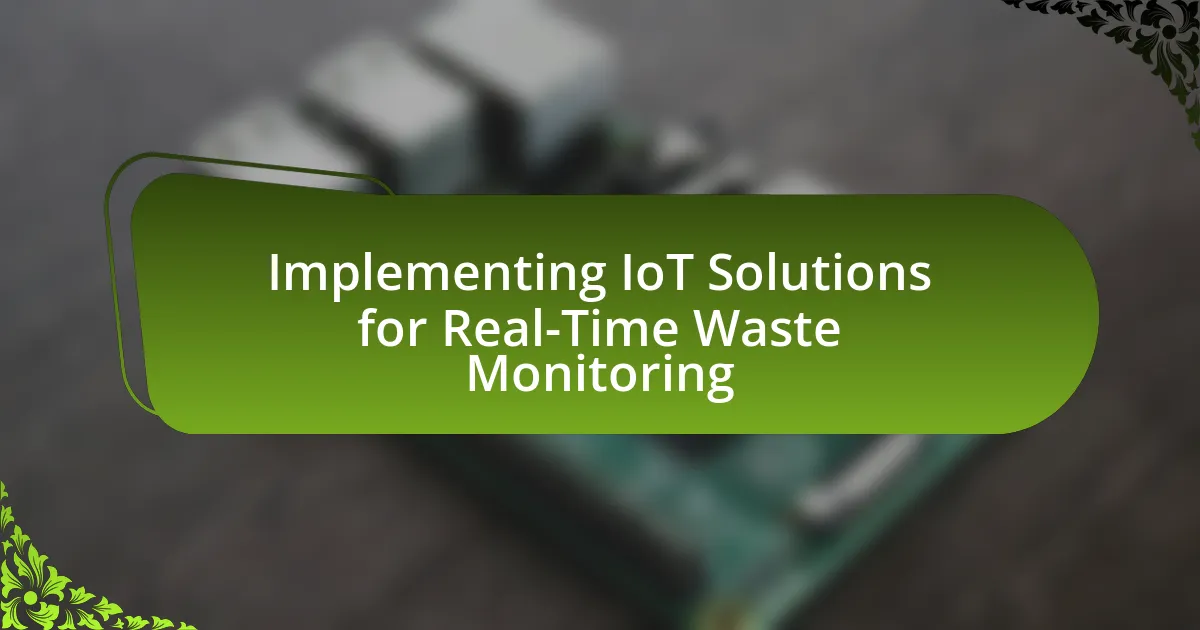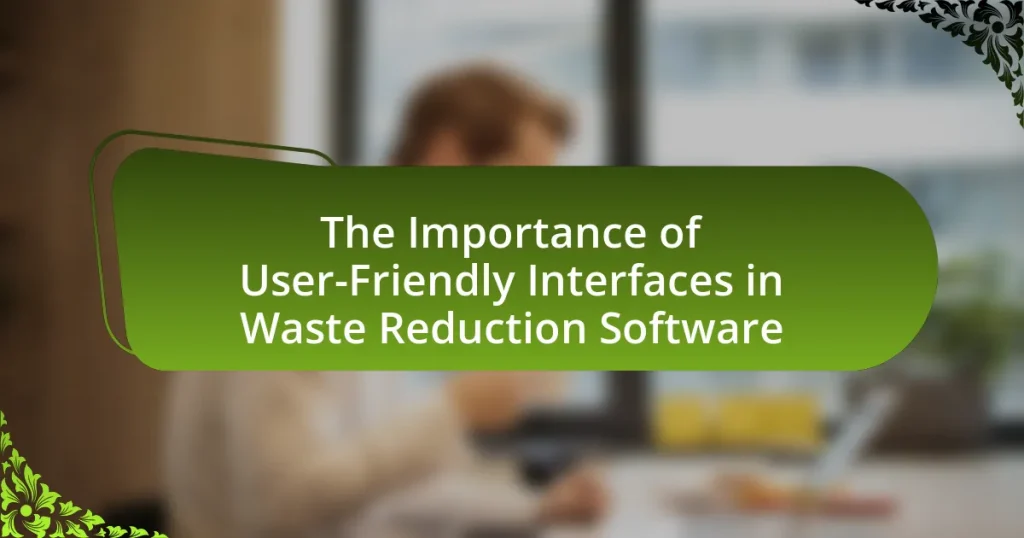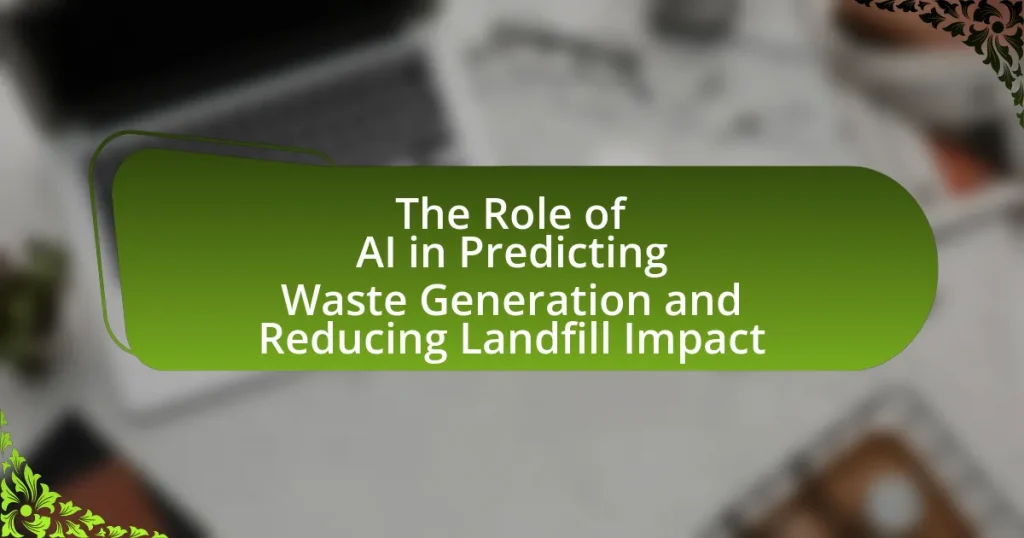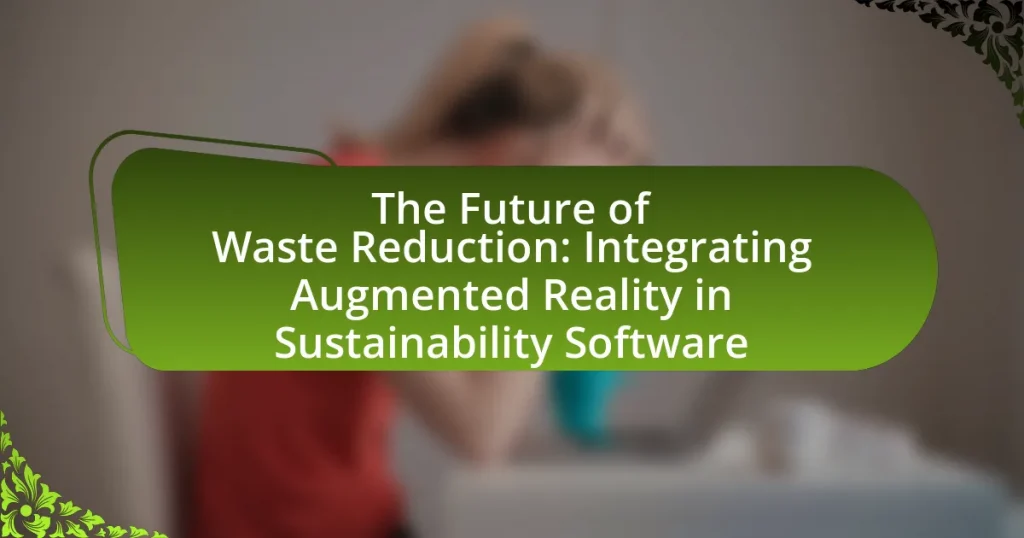Implementing IoT solutions for real-time waste monitoring involves the integration of interconnected devices and sensors to enhance waste management efficiency. These systems utilize smart bins equipped with sensors to track waste levels, optimize collection routes, and improve recycling efforts, leading to significant operational cost reductions and increased service efficiency. Key components include various types of sensors, communication networks, data analytics, and cloud computing, all of which facilitate real-time data collection and analysis. Challenges such as data privacy, interoperability, and infrastructure limitations must be addressed to ensure successful implementation. Future trends indicate a growing role for artificial intelligence and smart city initiatives in advancing waste management practices.
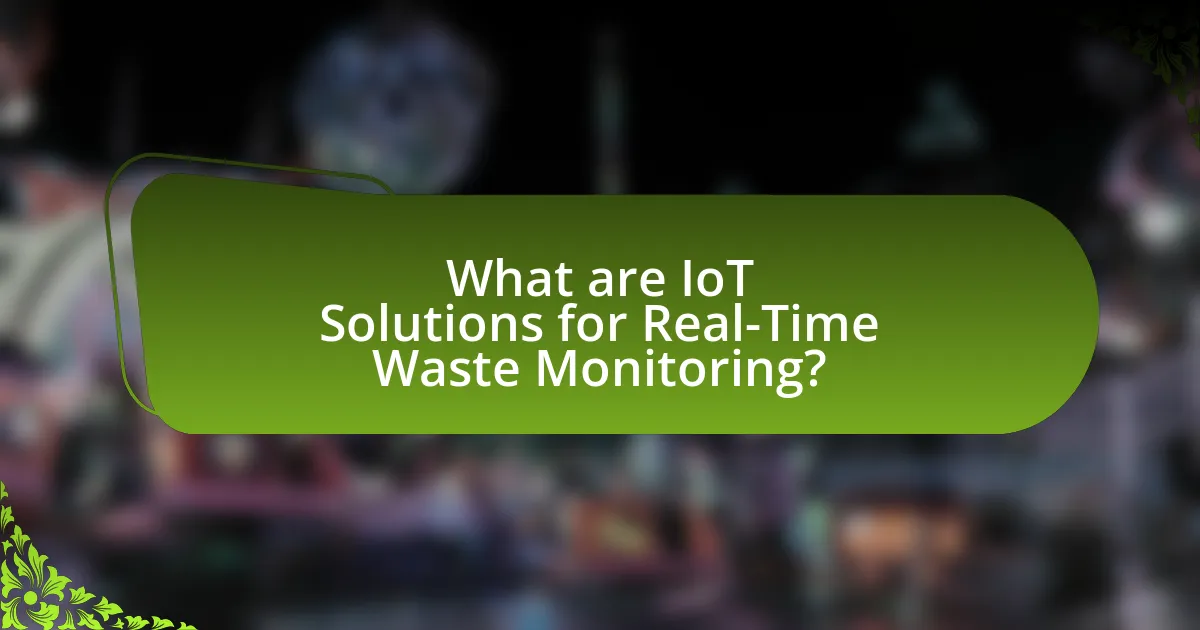
What are IoT Solutions for Real-Time Waste Monitoring?
IoT solutions for real-time waste monitoring involve the use of interconnected devices and sensors to track waste levels, optimize collection routes, and enhance recycling efforts. These solutions typically include smart bins equipped with fill-level sensors that transmit data to a centralized system, allowing waste management authorities to monitor waste accumulation in real-time. For instance, a study by the International Journal of Environmental Research and Public Health highlighted that implementing IoT-based waste management systems can reduce operational costs by up to 30% and improve collection efficiency by providing accurate data on waste levels.
How do IoT solutions enhance waste monitoring capabilities?
IoT solutions enhance waste monitoring capabilities by providing real-time data collection and analysis through connected sensors. These sensors can track waste levels, monitor bin conditions, and detect contamination, allowing for timely interventions and optimized collection routes. For instance, a study by the World Economic Forum indicates that smart waste management systems can reduce collection costs by up to 30% and improve recycling rates by providing accurate data on waste composition. This data-driven approach enables municipalities to make informed decisions, leading to more efficient waste management practices.
What technologies are involved in IoT waste monitoring solutions?
IoT waste monitoring solutions involve several key technologies, including sensors, communication networks, data analytics, and cloud computing. Sensors, such as ultrasonic or weight sensors, are deployed in waste bins to monitor fill levels and detect waste types. Communication networks, like LoRaWAN or cellular networks, transmit data from these sensors to centralized systems. Data analytics processes the collected information to provide insights on waste management efficiency. Cloud computing enables storage and accessibility of data, facilitating real-time monitoring and reporting. These technologies collectively enhance waste management practices by providing actionable data for optimization.
How do sensors and data analytics contribute to real-time monitoring?
Sensors and data analytics significantly enhance real-time monitoring by providing continuous data collection and analysis. Sensors, such as those used in waste management, detect various parameters like fill levels, temperature, and humidity, transmitting this information instantaneously to a central system. Data analytics processes this incoming data to identify patterns, predict trends, and generate actionable insights. For instance, a study by the International Journal of Environmental Research and Public Health found that integrating IoT sensors with data analytics in waste management can optimize collection routes, reducing operational costs by up to 30%. This synergy between sensors and analytics enables timely decision-making and efficient resource allocation, crucial for effective real-time monitoring.
What are the key components of an IoT waste monitoring system?
The key components of an IoT waste monitoring system include sensors, communication networks, data processing units, and user interfaces. Sensors are deployed in waste bins to measure fill levels, temperature, and weight, providing real-time data on waste accumulation. Communication networks, such as cellular, Wi-Fi, or LoRaWAN, transmit this data to a central server or cloud platform. Data processing units analyze the incoming data to generate insights, such as optimal collection routes and schedules. Finally, user interfaces, often in the form of mobile apps or dashboards, allow waste management authorities to monitor and manage waste collection efficiently. These components work together to enhance operational efficiency and reduce costs in waste management.
What types of sensors are used in waste monitoring?
Various types of sensors are used in waste monitoring, including ultrasonic sensors, weight sensors, infrared sensors, and gas sensors. Ultrasonic sensors measure the distance to the waste level, providing data on fill levels in bins. Weight sensors determine the mass of waste in containers, allowing for monitoring of capacity and collection needs. Infrared sensors detect the presence of waste and can identify specific materials, while gas sensors monitor emissions from waste, providing insights into decomposition and potential hazards. These sensors collectively enhance the efficiency of waste management systems by enabling real-time data collection and analysis.
How does data transmission work in these systems?
Data transmission in IoT systems for real-time waste monitoring occurs through the use of sensors that collect data on waste levels and environmental conditions. These sensors transmit the collected data to a central server or cloud platform using wireless communication protocols such as Wi-Fi, LoRaWAN, or cellular networks. The data is then processed and analyzed to provide insights into waste management, enabling timely actions such as scheduling pickups or optimizing routes. For instance, a study by the International Journal of Environmental Research and Public Health highlights that effective data transmission can improve operational efficiency by up to 30% in waste management systems.
What challenges are faced when implementing IoT solutions for waste monitoring?
Implementing IoT solutions for waste monitoring faces several challenges, including data privacy concerns, interoperability issues, and infrastructure limitations. Data privacy concerns arise from the collection and transmission of sensitive information, which can lead to potential breaches if not properly secured. Interoperability issues occur when different IoT devices and platforms do not communicate effectively, hindering the integration of various systems. Infrastructure limitations, such as inadequate internet connectivity in remote areas, can impede the deployment and functionality of IoT devices. These challenges must be addressed to ensure the successful implementation of IoT solutions in waste monitoring.
What are the technical challenges in deploying IoT waste monitoring systems?
The technical challenges in deploying IoT waste monitoring systems include connectivity issues, data management, sensor reliability, and integration with existing infrastructure. Connectivity issues arise due to the need for stable network coverage in various locations, which can hinder real-time data transmission. Data management challenges involve handling large volumes of data generated by sensors, requiring efficient storage and processing solutions. Sensor reliability is critical, as environmental factors can affect performance, leading to inaccurate readings. Finally, integration with existing waste management systems can be complex, necessitating compatibility with current technologies and processes to ensure seamless operation.
How can data privacy and security concerns be addressed?
Data privacy and security concerns can be addressed by implementing robust encryption protocols and access controls in IoT solutions for real-time waste monitoring. Encryption ensures that data transmitted between devices is secure, making it difficult for unauthorized users to intercept or access sensitive information. Access controls limit data access to authorized personnel only, reducing the risk of data breaches. According to a report by the International Data Corporation, organizations that adopt strong data protection measures can reduce the likelihood of data breaches by up to 80%. Additionally, regular security audits and compliance with data protection regulations, such as GDPR, further enhance data security and privacy.
How can cities benefit from real-time waste monitoring?
Cities can benefit from real-time waste monitoring by optimizing waste collection processes and reducing operational costs. This technology enables municipalities to track waste levels in bins, allowing for efficient scheduling of pickups based on actual need rather than fixed routes. For instance, a study by the World Bank found that cities implementing smart waste management systems can reduce collection costs by up to 30% while improving service delivery. Additionally, real-time data can enhance recycling rates by identifying contamination issues and informing residents about proper disposal methods.
What impact does real-time monitoring have on waste collection efficiency?
Real-time monitoring significantly enhances waste collection efficiency by optimizing route planning and reducing operational costs. By utilizing IoT sensors, waste management systems can track bin fill levels and adjust collection schedules accordingly, leading to fewer unnecessary pickups. A study by the World Bank found that cities implementing real-time monitoring experienced a 20-30% reduction in collection costs and improved service frequency, demonstrating the effectiveness of this technology in streamlining waste management processes.
How does it contribute to environmental sustainability?
Implementing IoT solutions for real-time waste monitoring contributes to environmental sustainability by optimizing waste management processes. These systems enable precise tracking of waste levels in bins, which reduces unnecessary collection trips, thereby lowering greenhouse gas emissions associated with transportation. According to a study by the World Economic Forum, smart waste management can reduce operational costs by up to 30% and decrease carbon emissions by 20-30% through efficient routing and scheduling. This data-driven approach not only minimizes resource consumption but also promotes recycling and proper waste disposal, further enhancing sustainability efforts.
What are the best practices for implementing IoT solutions in waste management?
The best practices for implementing IoT solutions in waste management include ensuring robust data collection, integrating real-time monitoring systems, and utilizing predictive analytics. Robust data collection involves deploying sensors that accurately measure waste levels and environmental conditions, which facilitates timely decision-making. Integrating real-time monitoring systems allows for immediate insights into waste collection needs, optimizing routes and schedules for waste management vehicles. Utilizing predictive analytics helps forecast waste generation trends, enabling proactive resource allocation. According to a study by the World Economic Forum, cities that adopt IoT solutions in waste management can reduce operational costs by up to 30% while improving service efficiency.
How can stakeholders ensure successful integration of IoT technologies?
Stakeholders can ensure successful integration of IoT technologies by establishing clear communication channels and collaboration among all parties involved. Effective collaboration fosters a shared understanding of goals, requirements, and challenges, which is essential for aligning IoT solutions with organizational objectives. Research indicates that organizations with strong stakeholder engagement in IoT projects experience a 30% higher success rate in implementation compared to those with minimal collaboration. Additionally, stakeholders should invest in training and education to enhance technical skills and knowledge related to IoT technologies, as this directly impacts the effectiveness of the integration process.
What strategies can be employed to maintain system reliability?
To maintain system reliability in IoT solutions for real-time waste monitoring, implementing redundancy and regular maintenance are essential strategies. Redundancy involves using multiple sensors and communication pathways to ensure that if one component fails, others can take over, thereby preventing data loss and system downtime. Regular maintenance, including software updates and hardware checks, ensures that all components function optimally and reduces the risk of unexpected failures. According to a study by the International Journal of Information Management, systems with built-in redundancy and scheduled maintenance showed a 30% increase in reliability compared to those without these strategies.
What future trends can be expected in IoT waste monitoring solutions?
Future trends in IoT waste monitoring solutions include increased integration of artificial intelligence for predictive analytics, enhanced sensor technology for real-time data collection, and the adoption of blockchain for improved data security and transparency. AI algorithms will enable waste management systems to predict waste generation patterns, optimizing collection routes and schedules, which can lead to a reduction in operational costs by up to 30%, as reported by the Waste Management Association. Additionally, advancements in sensor technology will allow for more accurate monitoring of waste levels, facilitating timely pickups and reducing overflow incidents. The implementation of blockchain technology will ensure secure and tamper-proof data sharing among stakeholders, enhancing accountability and trust in waste management processes.
How will advancements in AI and machine learning influence waste monitoring?
Advancements in AI and machine learning will significantly enhance waste monitoring by enabling real-time data analysis and predictive modeling. These technologies allow for the processing of vast amounts of data collected from IoT sensors, leading to improved accuracy in waste level detection and composition analysis. For instance, AI algorithms can identify patterns in waste generation, optimizing collection routes and schedules, which can reduce operational costs by up to 30% according to a study by the World Economic Forum. Furthermore, machine learning models can predict future waste trends, allowing municipalities to allocate resources more effectively and implement proactive waste management strategies.
What role will smart cities play in the evolution of waste management?
Smart cities will significantly enhance waste management through the integration of Internet of Things (IoT) solutions, enabling real-time monitoring and data-driven decision-making. By utilizing sensors and smart bins, cities can track waste levels, optimize collection routes, and reduce operational costs. For instance, a study by the International Telecommunication Union found that cities implementing smart waste management systems can reduce collection costs by up to 30% and improve recycling rates by 20%. This data-driven approach allows for more efficient resource allocation and promotes sustainability, ultimately transforming waste management practices in urban environments.
What practical tips can help organizations implement IoT waste monitoring effectively?
Organizations can implement IoT waste monitoring effectively by focusing on the integration of smart sensors, data analytics, and user-friendly interfaces. Smart sensors should be strategically placed in waste bins to collect real-time data on waste levels, enabling timely collection and reducing overflow incidents. Data analytics can be utilized to interpret the collected data, allowing organizations to optimize collection routes and schedules, which can lead to a reduction in operational costs by up to 30%, as reported by the Waste Management Association. Additionally, developing user-friendly interfaces for staff and stakeholders ensures that the data is accessible and actionable, facilitating informed decision-making. By combining these elements, organizations can enhance their waste management processes and improve sustainability outcomes.
